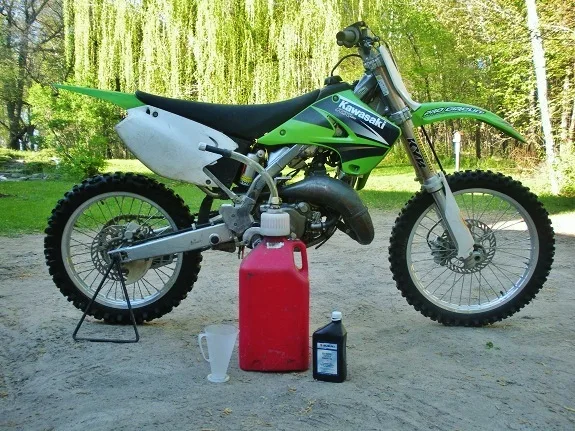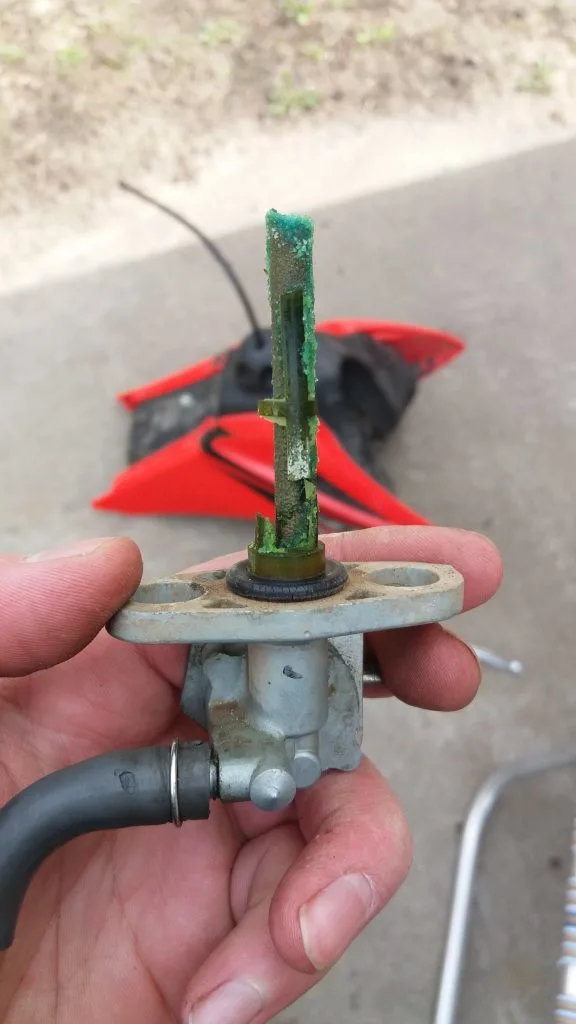When you realize you (or your buddy) put the wrong gas in your dirt bike, your heart feels like it’s in your throat because you’re thinking “Did I just ruin my dirt bike?!” Don’t worry, at least not yet, because you may not have done much, if any damage to it yet.
And if you did, then this short learning session will help you understand what to do in the future so that it hopefully never happens again.
In this article, you’re going to learn:
- The most common signs that you put the wrong gas in your dirt bike
- What to do based on what type of gas you used
- How to prevent fueling problems by learning what gas is best for your specific dirt bike!
![2008 WR450F 2 Put Wrong Gas In Your Dirt Bike? [Pro Tips On What To Do]](https://motocrosshideout.com/wp-content/uploads/2023/06/2008-WR450F-2-1200x675.jpg.webp)
What happens if you put the wrong gas in your dirt bike?
These are the most common problems that are caused by running the wrong gas in your dirt bike:
- Won’t start
- Hard starting/won’t stay running
- Excessive smoking
- Loud noises - knocking/pinging
- Poor throttle response
- Low power when accelerating
- Accelerated engine wear
- Engine damage/seizure
While these are all common signs of using the wrong gas, you may not have any of these if you didn’t use the right gas in your 2 stroke or 4 stroke dirt bike. Keep reading to learn more.
Can you put regular gas in a dirt bike?
It really depends on what kind of dirt bike you have. You can use regular 87-pump gas in most air-cooled 4-stroke trail bikes, such as a TTR125 or CRF250F because they have low compression and are made to run on lower octane and lower quality fuel.
However, if you have a high-performance motocross or enduro bike, such as an FC 250 or 300 XC, you will need to run at least 91 octane gas, or else it will cause premature engine damage from detonation.
Diesel
Whether your buddy was trying to “help out” by filling up your dirt bike gas can after filling his diesel truck or you simply forgot that you left diesel in your regular gas can, you definitely want to stop before you go out and ride before damaging your dirt bike’s engine.
In reality, you probably aren’t going to blow up your dirt bike engine if you try and start it with diesel. It might smoke a lot and foul the plug, but if you stop immediately, you should be fine.
![Gas Diesel Fuel Cans Put Wrong Gas In Your Dirt Bike? [Pro Tips On What To Do]](https://motocrosshideout.com/wp-content/uploads/2023/06/Gas-Diesel-Fuel-Cans.jpg.webp)
If you put diesel in your dirt bike then follow these steps:
- Turn the fuel petcock off
- Completely drain the carburetor of fuel
- Completely drain the gas tank of the diesel
- Replace the spark plug
- Add fresh gas (non-oxygenated is usually best for most stock dirt bikes)
- Start and properly warm up the engine
- Go out and ride!
Ethanol
Unfortunately in today’s world, almost all regular pump gas has ethanol in it, but why is that bad? Ethanol
Pros:
- Less potential emissions
- E85 can be used in high-compression engines (due to higher octane)
- Uses more “recycled” materials when produced
Cons:
- Less fuel efficient (shorter range, requiring more frequent fill-ups)
- Less stable - goes bad quickly when sitting
- Absorbs water easily from sitting in humid locations - causes starting/running/bogging issues
![Ethanol Gas Pump Sticker E15 Put Wrong Gas In Your Dirt Bike? [Pro Tips On What To Do]](https://motocrosshideout.com/wp-content/uploads/2023/06/Ethanol-Gas-Pump-Sticker-E15.jpg.webp)
There’s usually 10-15% ethanol in regular pump gas (the label at every pump should say on the sticker how much it has), so if you can’t choose one that has 0% ethanol, then choose the one with the least amount if you want fewer issues in the long run.
Pro Tip: If you have to use gas with ethanol in your dirt bike, only fill up as much as you need so that it doesn’t go bad from sitting. If it sits for more than a week, you’ll want to fill the tank all the way to the top so that there’s less “room” for water to be absorbed into the tank.
Mixed gas in a 4-stroke?
Maybe you own both 2 stroke & 4 stroke dirt bikes but forgot to label which one is “Mixed” with 2-stroke oil. Or perhaps you changed what kind of gas (again) in your regular dirt bike gas can (doh!).
Don’t worry - in fact, you might not even need to do anything if you put 2-stroke pre-mixed gas into your 4 stroke dirt bike. The 2-stroke oil will act as extra lubricity in your engine (some people like to add a little bit just for this reason), but the worst-case scenario is usually just a fouled plug.
![2023 Yamaha YZ450FX Put Wrong Gas In Your Dirt Bike? [Pro Tips On What To Do]](https://motocrosshideout.com/wp-content/uploads/2023/04/2023-Yamaha-YZ450FX-1200x736.jpg.webp)
What happens when you run mixed gas in a 4-stroke dirt bike?
For 50:1, 60:1, or high ratios (with less oil-to-gas), you can probably get away with running it as is - it will probably smoke a little bit, even when the engine is fully warmed up.
With a thicker/higher ratio of oil, such as 32:1, you’re more likely to have jetting issues and it could foul the spark plug or have poor throttle response, such as bogging because the air-fuel ratio is different.
Un-mixed in a 2-stroke?
On the flip side, you could just as easily put gas into your 2-stroke without premixing it with 2 stroke oil - or perhaps you have an oil-injected 2 stroke engine and forget to fill the oil reservoir/tank and it ran empty.
THIS IS A MAJOR PROBLEM!!
I don’t mean to shout, but there’s a reason why there needs to be oil in your 2 stroke gas - the oil is a lubricant that lubes the top-end parts while running to prevent excessive friction and heat.
When there’s not enough, or in this case, zero oil in the fuel, it’s going to create a lot more friction, which turns into heat, which causes a meltdown or engine seizure.
What to do if you started your 2 stroke dirt bike without oil in the gas
If you just started your 2 stroke and immediately remembered that there’s no oil in the gas and then shut it off within 10 seconds or so, then you probably didn’t do any serious damage, if at all - this is because there’s usually residual oil sitting on and around the top-end parts.
But, if you run it much longer, your risk of burning down your engine exponentially goes up with every passing minute.
If you run it for more than a minute, I would immediately shut it off and check the engine compression.
Incorrectly mixed gas in your 2-stroke
2 stroke oil mix ratio is often misinterpreted with 2 stroke carb jetting because it can play a role in how your dirt bike runs. However, the amount of 2 stroke oil you mix into your gas tank mainly depends on two important factors - what RPM you mainly ride at and what kind of oil you’re using.

For example, if you’re a casual rider that’s in the low to mid-RPM range, you don’t need as much oil, and you also don’t need a racing 2 stroke oil that burns at a higher temperature.
This is one of the reasons why it’s easy to gum up the power valves if your 2 stroke engine has them.
What to do if there’s too much oil mixed into your 2 stroke gas
Let’s say you have a two-gallon gas tank that you want to have mixed at 32:1. This means you need 4 ounces per gallon and 8 ounces total, but you accidentally added 16 ounces, making it a 16:1 oil mix ratio.
Will it ruin the engine if you run it? No, more oil will definitely not hurt it, but it will smoke more and probably not run as well.
![Pre Mix 101 3 Put Wrong Gas In Your Dirt Bike? [Pro Tips On What To Do]](https://motocrosshideout.com/wp-content/uploads/2020/01/Pre-Mix-101-3-1024x768.jpg.webp)
The best thing to do, as annoying as it may be, is completely drain the 2 gallons into a 5-gallon can/jug and then add 2 more gallons of fresh gas. This gives you 4 gallons of properly mixed 2 stroke fuel that you can start adding back into your 2 stroke dirt bike.
What to do if there’s not enough 2 stroke oil mixed in the gas
This problem is even easier to deal with because you don’t have to drain the gas tank. Just calculate how much oil you added already, then add the amount needed to get the proper oil mix ratio.
For example, if you need 32:1 in two gallons (16 ounces) but only have 64:1 (8 ounces), then just add 8 more ounces.
Pro Tip: For mixing gas, it’s best to add the oil first, whether it’s your gas can or dirt bike gas tank, then add the gas after. This will help mix it up better for a consistent fuel ratio. I also like to shake my dirt bike fuel up before turning the petcock on for the first time each ride.
Old gas - how to tell when it's bad
Any kind of gas can go bad, and a good way to tell if it’s bad is when you remove the gas cap and it smells like old paint or varnish - it’s a very distinct smell compared to fresh gas.
The lower the quality of gas the sooner it will break down and go bad. Pump gas with high amounts of ethanol usually goes bad the quickest.
Old gas will cause these problems/symptoms:
- It won’t start
- It won’t stay running
- Can clog the carb/fuel system
- Bogging
- Hesitation/poor throttle response
- Lack of power
Not only is it frustrating to have a poor-running dirt bike when using old gas, but it can also be dangerous.
Think about it - if you’re doing jumps or need to accelerate to get over an obstacle and the engine cuts out right when you need that last “blip” of acceleration, the front end will drop and bad things can happen quickly!
![ERX 6 13 09 Put Wrong Gas In Your Dirt Bike? [Pro Tips On What To Do]](https://motocrosshideout.com/wp-content/uploads/2020/03/ERX-6-13-09.jpg.webp)
What to do if your dirt bike has old gas in the fuel tank:
Whether you know the gas is bad or you’ve already tried starting your dirt bike after it’s been sitting for a few months (or years) with no success, it’s time to drain the old gas.
The first step is to drain the carburetor (if your dirt bike has one). Old gas often sits at the bottom of the float bowl, and if it gets sucked up into the jet passages, you’re probably going to have to disassemble it for a thorough cleaning.
![How To Clean A Dirt Bike Carb 13 Put Wrong Gas In Your Dirt Bike? [Pro Tips On What To Do]](https://motocrosshideout.com/wp-content/uploads/2022/11/How-To-Clean-A-Dirt-Bike-Carb-13.jpg.webp)
Next, you’ll need to drain the fuel tank if there’s old gas in it. If you have a fuel filter inline or in the gas tank, inspect that to make sure it’s not blocked or clogged up.
Replace the filter if necessary and then add fresh gas to your dirt bike and re-try starting it.

What to do if you tried fresh gas and it still won’t start
When it won’t start after draining old gas and putting new gas in, then it’s probably due to the carb being dirty. If it started and ran just fine when you parked the bike, then it will need a proper carb clean.
This requires the removal of the carburetor, which is actually pretty easy on most dirt bikes. The end result will make it start and run like new again if it’s just a tiny passage that’s clogged - something that carb cleaner (Amazon) and a jet cleaning brush (Amazon) or compressed air can’t always get by itself.
High octane
Whether you 93 octane Premium pump gas or 110 octane race gas (Amazon) into your dirt bike, it’s not going to hurt it, but it might cause some issues or you might just be throwing your money away.
First, higher octane gas generally burns at a slower rate. This will affect the jetting and can make it rich enough to cause problems, such as:
- Flooding - carb or engine overfills with gas
- Hesitation - it doesn’t smoothly accelerate when you turn the throttle
- Lacking power - acceleration is slower, especially on top-end
- Overall poor throttle response
Do you get more horsepower with higher octane?
Next, many people think that higher octane gas means it will make more power compared to a gas with a lower octane rating. That is 100% INCORRECT if that’s the only thing different between the two types of gas.
What does high-octane actually do for your dirt bike?
Higher octane simply resists detonation, which causes excessive wear and knocking on your engine. This is most common in engines with a high compression ratio, but what exactly is “high compression” for a dirt bike?
The point where you need higher octane/race gas in your dirt bike depends on what type of engine you have. For example, a liquid-cooled engine can have a higher compression ratio compared to an air-cooled engine if they’re both running the same octane of pump gas because the liquid-cooled engine is more stable and can keep the engine cooler.
As a general reference, these are the maximum compression ratios that you can run with 91 Premium Pump Gas:
- Air-cooled engine: 11.5:1
- Liquid-cooled engine: 13.5:1
*Caution: these numbers above are just a general guideline - there’s potential to have issues, depending on many other factors, such as a few listed below…
Other variables that affect reliability with high compression and fuel
The compression ratio isn’t the only thing to consider when choosing the right octane rating in your gas.
For example, these factors play a role in the reliability and performance of your dirt bike:
- Jetting - Leaner jetting is more likely to pre-ignite and cause problems
- Timing - Advancing the timing can get more power but will generally require a higher octane
- 4-stroke cam timing - A cam with a low duration time will increase “static compression” and be more likely to cause detonation
- Elevation - Thinner air means you can use a lower octane as you go up in elevation (87 at Sea level is similar to 85 at 5000 ft. elevation)
What octane should you use?
For the best efficiency and to save the most money, only use as high of octane as your dirt bike needs. For example, if you have a stock YZ250FX, then you don’t need 110 or even 100 octane race gas or AVGAS. 93 Premium is enough in most cases.
As long as your dirt bike starts and runs well without any weird noises or issues, you don’t need to use a higher-octane gas - you’re simply throwing money away unless you’re tuning the carb/EFI for a special race gas that has other additives for more torque/horsepower.
Other benefits of race fuel with high octane
While a higher octane won’t give you more power, a more expensive race gas has other benefits that might be worth it if you don’t mind spending $10-25 per gallon (yes, it’s very expensive!)
For example, these are a few major benefits of using a high-quality race gas in your dirt bike when properly tuned for it:
- Some additives can increase horsepower by close to 5% (that’s a lot for just changing gas)
- It’s very stable - You can expect a consistent throttle response because the ingredients/additives are of higher quality and don’t break down as quickly)
- Longer shelf-life - Can last much longer when sitting without “going bad” compared to pump-gas
Caution: Race gas won’t last long after you’ve mixed it with pump gas (and especially 2-stroke oil). It’s best to only mix it as needed or else it can cause engine problems - ask me how I know! (insert “crying” emoji)
Low octane
Based on what you just learned… are you running too low of octane in your dirt bike?
Here are the most common signs that you need a higher octane gas in your dirt bike:
- Knocking - especially under a heavy load/acceleration (riding in sand or up a hill)
- Pinging - does it sound like a box of marbles?
- Bogging
- Lacking power
- Poor acceleration/power
If the octane is too low, such as 87 octane when you should be using 91 or 93 octane, then it’s best to stop immediately. If your dirt bike has a full tank of gas then you’ll want to drain it all out and replace it with the correct octane of gas.
If there’s only a little bit of gas in the tank, then you can probably get away with filling it with the proper gas or adding a good octane booster (Amazon).
What type of gas is right for your dirt bike?
What are your goals and what is your budget? Here are the best options depending on what you want and how you use your dirt bike:
- Cheapest - Regular pump gas (choose the lowest amount of ethanol possible). The gas has the shortest life, so don’t let it sit for more than a few weeks or else it will go bad
- Cheap & more reliable - Non-oxy 91/93 pump gas. More stable and longer-lasting than regular pump gas - works well in virtually any stock dirt bike
- Expensive but consistent - 100LL AVGAS, which is airplane gas. Can run higher compression with good reliability when properly tuned, consistency, and longer shelf-life, but the lead can foul spark plugs and gum up valves, and it may be illegal at sanctioned races
- Maximum performance & cost - Race gas (Amazon), specially made for high-compression and high-performance engines. Requires proper tuning for best performance.
How to prevent a catastrophic engine failure
Using the right gas is one way to keep your dirt bike running strong and reliable, but there are a few more common mistakes that cause people to get stranded in the middle of nowhere with a broken-down dirt bike. I want to show you how to prevent this from happening with my FREE guide that you can get here.

